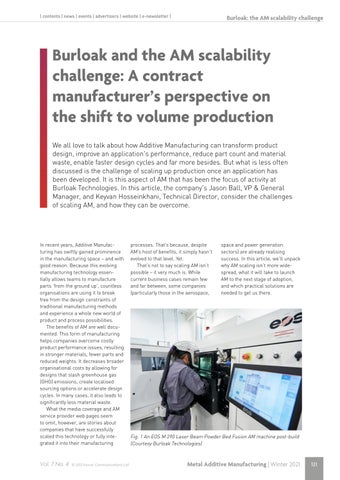| contents | news | events | advertisers | website | e-newsletter |
Burloak: the AM scalability challenge
Burloak and the AM scalability challenge: A contract manufacturer’s perspective on the shift to volume production We all love to talk about how Additive Manufacturing can transform product design, improve an application's performance, reduce part count and material waste, enable faster design cycles and far more besides. But what is less often discussed is the challenge of scaling up production once an application has been developed. It is this aspect of AM that has been the focus of activity at Burloak Technologies. In this article, the company's Jason Ball, VP & General Manager, and Keyvan Hosseinkhani, Technical Director, consider the challenges of scaling AM, and how they can be overcome.
In recent years, Additive Manufacturing has swiftly gained prominence in the manufacturing space – and with good reason. Because this evolving manufacturing technology essentially allows teams to manufacture parts ‘from the ground up’, countless organisations are using it to break free from the design constraints of traditional manufacturing methods and experience a whole new world of product and process possibilities. The benefits of AM are well documented. This form of manufacturing helps companies overcome costly product performance issues, resulting in stronger materials, fewer parts and reduced weights. It decreases broader organisational costs by allowing for designs that slash greenhouse gas (GHG) emissions, create localised sourcing options or accelerate design cycles. In many cases, it also leads to significantly less material waste. What the media coverage and AM service provider web pages seem to omit, however, are stories about companies that have successfully scaled this technology or fully integrated it into their manufacturing
Vol. 7 No. 4 © 2021 Inovar Communications Ltd
processes. That’s because, despite AM’s host of benefits, it simply hasn’t evolved to that level. Yet. That’s not to say scaling AM isn’t possible – it very much is. While current business cases remain few and far between, some companies (particularly those in the aerospace,
space and power generation sectors) are already realising success. In this article, we’ll unpack why AM scaling isn’t more widespread, what it will take to launch AM to the next stage of adoption, and which practical solutions are needed to get us there.
Fig. 1 An EOS M 290 Laser Beam Powder Bed Fusion AM machine post-build (Courtesy Burloak Technologies)
Metal Additive Manufacturing | Winter 2021
121
